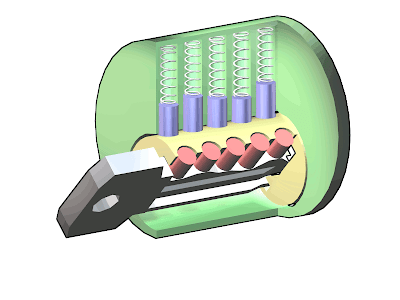 Next part, the plug has a holes drilled in it and these continue up into the casing. Each of thise holes has a spring in it. The spring pushes two little pins down into the plug. The top pins (which are between the spring and bottom pin) are called drivingpins and they are all the same length. They push the lower pins (called the keypins) down. These keypins are all different lengths. They rest on a little ledge called a ward. Pull your keys out of your pocket and look at one. It has that little canal that runs all the way from the tip to the handle of the key. The ward slides in the canal. The point of the ward is to be a ledge that the keypins rest on when there is no key in the keyway.
Next part, the plug has a holes drilled in it and these continue up into the casing. Each of thise holes has a spring in it. The spring pushes two little pins down into the plug. The top pins (which are between the spring and bottom pin) are called drivingpins and they are all the same length. They push the lower pins (called the keypins) down. These keypins are all different lengths. They rest on a little ledge called a ward. Pull your keys out of your pocket and look at one. It has that little canal that runs all the way from the tip to the handle of the key. The ward slides in the canal. The point of the ward is to be a ledge that the keypins rest on when there is no key in the keyway.So that's all the pieces of the lock. Now how does it work. I said that all the keypins were different lengths. Why? Well, what else are different heights? Answer: the teeth of the key.
 So here is how it works. The key goes into the keyway. The notches and teeth push the pins up to exactly the right height so that each and every one of the top drivingpins is lifted (by the keypins) to the same height (exactly to the same height as the separation between the casing and the plug). This is the most important part to understand. When the key is inserted the gap between each and every keypin and drivingpin lines up with the gap between the hull casing and the plug. This separation is called the shear line. Once they are all lined up the key can turn and unlock the door. Tada! The mechanism of a tumbler lock explained!
So here is how it works. The key goes into the keyway. The notches and teeth push the pins up to exactly the right height so that each and every one of the top drivingpins is lifted (by the keypins) to the same height (exactly to the same height as the separation between the casing and the plug). This is the most important part to understand. When the key is inserted the gap between each and every keypin and drivingpin lines up with the gap between the hull casing and the plug. This separation is called the shear line. Once they are all lined up the key can turn and unlock the door. Tada! The mechanism of a tumbler lock explained!
Check out these wikis if you want to read about the mechanism of tumbler locks again. (Let's be honest. It's where I got the images)
Wikivisual
Wikipedia
Wapedia
BambooWeb Dictionary
BookRags
Let this settle for a day or so and then I'll post a How-To tutorial for picking tumbler locks.






































No comments:
Post a Comment